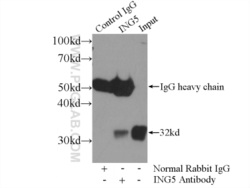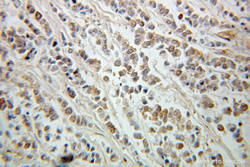Antibody data
- Antibody Data
- Antigen structure
- References [26]
- Comments [0]
- Validations
- Western blot [1]
- Immunoprecipitation [1]
- Immunohistochemistry [1]
Submit
Validation data
Reference
Comment
Report error
- Product number
- 10665-1-AP - Provider product page

- Provider
- Proteintech Group
- Proper citation
- Proteintech Cat#10665-1-AP, RRID:AB_2280522
- Product name
- ING5 antibody
- Antibody type
- Polyclonal
- Description
- KD/KO validated ING5 antibody (Cat. #10665-1-AP) is a rabbit polyclonal antibody that shows reactivity with human, mouse, rat and has been validated for the following applications: IHC, IP, WB, ELISA.
- Reactivity
- Human, Mouse, Rat
- Host
- Rabbit
- Conjugate
- Unconjugated
- Isotype
- IgG
- Vial size
- 20ul, 150ul
Submitted references Transcriptional Regulation of ING5 and its Suppressive Effects on Gastric Cancer.
SCF(JFK) is functionally linked to obesity and metabolic syndrome.
LRP6 downregulation promotes cardiomyocyte proliferation and heart regeneration.
MicroRNA-196b-5p promotes malignant progression of colorectal cancer by targeting ING5.
The Roles of Beclin 1 Expression in Gastric Cancer: A Marker for Carcinogenesis, Aggressive Behaviors and Favorable Prognosis, and a Target of Gene Therapy.
MEAF6 is essential for cell proliferation and plays a role in the assembly of KAT7 complexes.
ING5 inhibits cancer aggressiveness by inhibiting Akt and activating p53 in prostate cancer.
ING5 inhibits lung cancer invasion and epithelial-mesenchymal transition by inhibiting the WNT/β-catenin pathway.
ING5 differentially regulates protein lysine acetylation and promotes p300 autoacetylation.
The nucleocytoplasmic translocation and up-regulation of ING5 protein in breast cancer: a potential target for gene therapy.
The roles of ING5 expression in ovarian carcinogenesis and subsequent progression: a target of gene therapy.
ING5 suppresses breast cancer progression and is regulated by miR-24.
The roles of ING5 in gliomas: a good marker for tumorigenesis and a potential target for gene therapy.
ING5 knockdown enhances migration and invasion of lung cancer cells by inducing EMT via EGFR/PI3K/Akt and IL-6/STAT3 signaling pathways.
Identification of Epigenetic Factor Proteins Expressed in Human Embryonic Stem Cell-Derived Trophoblasts and in Human Placental Trophoblasts.
Upregulated in Hepatitis B virus-associated hepatocellular carcinoma cells, miR-331-3p promotes proliferation of hepatocellular carcinoma cells by targeting ING5.
ING5 inhibits cancer aggressiveness via preventing EMT and is a potential prognostic biomarker for lung cancer.
MiR-193a-3p promotes the multi-chemoresistance of bladder cancer by targeting the HOXC9 gene.
ING5 suppresses proliferation, apoptosis, migration and invasion, and induces autophagy and differentiation of gastric cancer cells: a good marker for carcinogenesis and subsequent progression.
The miR-193a-3p-regulated ING5 gene activates the DNA damage response pathway and inhibits multi-chemoresistance in bladder cancer.
A targeted RNA interference screen reveals novel epigenetic factors that regulate herpesviral gene expression.
Aberrant expression miR-196a is associated with abnormal apoptosis, invasion, and proliferation of pancreatic cancer cells.
MicroRNA-193 pro-proliferation effects for bone mesenchymal stem cells after low-level laser irradiation treatment through inhibitor of growth family, member 5.
The nuclear to cytoplasmic shift of ING5 protein during colorectal carcinogenesis with their distinct links to pathologic behaviors of carcinomas.
The altered expression of ING5 protein is involved in gastric carcinogenesis and subsequent progression.
Decreased nuclear expression and increased cytoplasmic expression of ING5 may be linked to tumorigenesis and progression in human head and neck squamous cell carcinoma.
Zheng HC, Xue H, Wu X, Xu HL, Zhao EH, Cui ZG
Frontiers in oncology 2022;12:918954
Frontiers in oncology 2022;12:918954
SCF(JFK) is functionally linked to obesity and metabolic syndrome.
He L, Yan R, Yang Z, Zhang Y, Liu X, Yang J, Liu X, Liu X, Xia L, Wang Y, Wu J, Wu X, Shan L, Yang X, Liang J, Shang Y, Sun L
EMBO reports 2021 Jul 5;22(7):e52036
EMBO reports 2021 Jul 5;22(7):e52036
LRP6 downregulation promotes cardiomyocyte proliferation and heart regeneration.
Wu Y, Zhou L, Liu H, Duan R, Zhou H, Zhang F, He X, Lu D, Xiong K, Xiong M, Zhuang J, Liu Y, Li L, Liang D, Chen YH
Cell research 2021 Apr;31(4):450-462
Cell research 2021 Apr;31(4):450-462
MicroRNA-196b-5p promotes malignant progression of colorectal cancer by targeting ING5.
Xin H, Wang C, Chi Y, Liu Z
Cancer cell international 2020;20:119
Cancer cell international 2020;20:119
The Roles of Beclin 1 Expression in Gastric Cancer: A Marker for Carcinogenesis, Aggressive Behaviors and Favorable Prognosis, and a Target of Gene Therapy.
Zheng HC, Zhao S, Xue H, Zhao EH, Jiang HM, Hao CL
Frontiers in oncology 2020;10:613679
Frontiers in oncology 2020;10:613679
MEAF6 is essential for cell proliferation and plays a role in the assembly of KAT7 complexes.
Matsuura K, Tani N, Usuki S, Torikai-Nishikawa S, Okano M, Niwa H
Experimental cell research 2020 Nov 1;396(1):112279
Experimental cell research 2020 Nov 1;396(1):112279
ING5 inhibits cancer aggressiveness by inhibiting Akt and activating p53 in prostate cancer.
Barlak N, Capik O, Sanli F, Kilic A, Aytatli A, Yazici A, Ortucu S, Ittmann M, Karatas OF
Cell biology international 2020 Jan;44(1):242-252
Cell biology international 2020 Jan;44(1):242-252
ING5 inhibits lung cancer invasion and epithelial-mesenchymal transition by inhibiting the WNT/β-catenin pathway.
Liu XL, Meng J, Zhang XT, Liang XH, Zhang F, Zhao GR, Zhang T
Thoracic cancer 2019 Apr;10(4):848-855
Thoracic cancer 2019 Apr;10(4):848-855
ING5 differentially regulates protein lysine acetylation and promotes p300 autoacetylation.
Zhang T, Meng J, Liu X, Zhang X, Peng X, Cheng Z, Zhang F
Oncotarget 2018 Jan 5;9(2):1617-1629
Oncotarget 2018 Jan 5;9(2):1617-1629
The nucleocytoplasmic translocation and up-regulation of ING5 protein in breast cancer: a potential target for gene therapy.
Ding XQ, Zhao S, Yang L, Zhao X, Zhao GF, Zhao SP, Li ZJ, Zheng HC
Oncotarget 2017 Oct 10;8(47):81953-81966
Oncotarget 2017 Oct 10;8(47):81953-81966
The roles of ING5 expression in ovarian carcinogenesis and subsequent progression: a target of gene therapy.
Zheng HC, Zhao S, Song Y, Ding XQ
Oncotarget 2017 Nov 28;8(61):103449-103464
Oncotarget 2017 Nov 28;8(61):103449-103464
ING5 suppresses breast cancer progression and is regulated by miR-24.
Cui S, Liao X, Ye C, Yin X, Liu M, Hong Y, Yu M, Liu Y, Liang H, Zhang CY, Chen X
Molecular cancer 2017 May 10;16(1):89
Molecular cancer 2017 May 10;16(1):89
The roles of ING5 in gliomas: a good marker for tumorigenesis and a potential target for gene therapy.
Zhao S, Zhao ZJ, He HY, Wu JC, Ding XQ, Yang L, Jia N, Li ZJ, Zheng HC
Oncotarget 2017 Aug 22;8(34):56558-56568
Oncotarget 2017 Aug 22;8(34):56558-56568
ING5 knockdown enhances migration and invasion of lung cancer cells by inducing EMT via EGFR/PI3K/Akt and IL-6/STAT3 signaling pathways.
Liu XL, Zhang XT, Meng J, Zhang HF, Zhao Y, Li C, Sun Y, Mei QB, Zhang F, Zhang T
Oncotarget 2017 Aug 15;8(33):54265-54276
Oncotarget 2017 Aug 15;8(33):54265-54276
Identification of Epigenetic Factor Proteins Expressed in Human Embryonic Stem Cell-Derived Trophoblasts and in Human Placental Trophoblasts.
Sarkar P, Mischler A, Randall SM, Collier TS, Dorman KF, Boggess KA, Muddiman DC, Rao BM
Journal of proteome research 2016 Aug 5;15(8):2433-44
Journal of proteome research 2016 Aug 5;15(8):2433-44
Upregulated in Hepatitis B virus-associated hepatocellular carcinoma cells, miR-331-3p promotes proliferation of hepatocellular carcinoma cells by targeting ING5.
Cao Y, Chen J, Wang D, Peng H, Tan X, Xiong D, Huang A, Tang H
Oncotarget 2015 Nov 10;6(35):38093-106
Oncotarget 2015 Nov 10;6(35):38093-106
ING5 inhibits cancer aggressiveness via preventing EMT and is a potential prognostic biomarker for lung cancer.
Zhang F, Zhang X, Meng J, Zhao Y, Liu X, Liu Y, Wang Y, Li Y, Sun Y, Wang Z, Mei Q, Zhang T
Oncotarget 2015 Jun 30;6(18):16239-52
Oncotarget 2015 Jun 30;6(18):16239-52
MiR-193a-3p promotes the multi-chemoresistance of bladder cancer by targeting the HOXC9 gene.
Lv L, Li Y, Deng H, Zhang C, Pu Y, Qian L, Xiao J, Zhao W, Liu Q, Zhang D, Wang Y, Zhang H, He Y, Zhu J
Cancer letters 2015 Feb 1;357(1):105-113
Cancer letters 2015 Feb 1;357(1):105-113
ING5 suppresses proliferation, apoptosis, migration and invasion, and induces autophagy and differentiation of gastric cancer cells: a good marker for carcinogenesis and subsequent progression.
Gou WF, Shen DF, Yang XF, Zhao S, Liu YP, Sun HZ, Su RJ, Luo JS, Zheng HC
Oncotarget 2015 Aug 14;6(23):19552-79
Oncotarget 2015 Aug 14;6(23):19552-79
The miR-193a-3p-regulated ING5 gene activates the DNA damage response pathway and inhibits multi-chemoresistance in bladder cancer.
Li Y, Deng H, Lv L, Zhang C, Qian L, Xiao J, Zhao W, Liu Q, Zhang D, Wang Y, Yan J, Zhang H, He Y, Zhu J
Oncotarget 2015 Apr 30;6(12):10195-206
Oncotarget 2015 Apr 30;6(12):10195-206
A targeted RNA interference screen reveals novel epigenetic factors that regulate herpesviral gene expression.
Oh HS, Bryant KF, Nieland TJ, Mazumder A, Bagul M, Bathe M, Root DE, Knipe DM
mBio 2014 Feb 4;5(1):e01086-13
mBio 2014 Feb 4;5(1):e01086-13
Aberrant expression miR-196a is associated with abnormal apoptosis, invasion, and proliferation of pancreatic cancer cells.
Liu M, Du Y, Gao J, Liu J, Kong X, Gong Y, Li Z, Wu H, Chen H
Pancreas 2013 Oct;42(7):1169-81
Pancreas 2013 Oct;42(7):1169-81
MicroRNA-193 pro-proliferation effects for bone mesenchymal stem cells after low-level laser irradiation treatment through inhibitor of growth family, member 5.
Wang J, Huang W, Wu Y, Hou J, Nie Y, Gu H, Li J, Hu S, Zhang H
Stem cells and development 2012 Sep 1;21(13):2508-19
Stem cells and development 2012 Sep 1;21(13):2508-19
The nuclear to cytoplasmic shift of ING5 protein during colorectal carcinogenesis with their distinct links to pathologic behaviors of carcinomas.
Zheng HC, Xia P, Xu XY, Takahashi H, Takano Y
Human pathology 2011 Mar;42(3):424-33
Human pathology 2011 Mar;42(3):424-33
The altered expression of ING5 protein is involved in gastric carcinogenesis and subsequent progression.
Xing YN, Yang X, Xu XY, Zheng Y, Xu HM, Takano Y, Zheng HC
Human pathology 2011 Jan;42(1):25-35
Human pathology 2011 Jan;42(1):25-35
Decreased nuclear expression and increased cytoplasmic expression of ING5 may be linked to tumorigenesis and progression in human head and neck squamous cell carcinoma.
Li X, Nishida T, Noguchi A, Zheng Y, Takahashi H, Yang X, Masuda S, Takano Y
Journal of cancer research and clinical oncology 2010 Oct;136(10):1573-83
Journal of cancer research and clinical oncology 2010 Oct;136(10):1573-83
No comments: Submit comment
Supportive validation
- Submitted by
- Proteintech Group (provider)
- Main image

- Experimental details
- Jurkat cells were subjected to SDS PAGE followed by western blot with 10665-1-AP(ING5 antibody) at dilution of 1:1000
- Sample type
- cell line
Supportive validation
- Submitted by
- Proteintech Group (provider)
- Main image

- Experimental details
- IP Result of anti-ING5 (IP:10665-1-AP, 4ug; Detection:10665-1-AP 1:700) with HEK-293 cells lysate 2560ug.
- Sample type
- cell line
Supportive validation
- Submitted by
- Proteintech Group (provider)
- Main image

- Experimental details
- The ING5 antibody from Proteintech is a rabbit polyclonal antibody to a recombinant protein of human ING5. This antibody recognizes human, mouse, rat antigen. The ING5 antibody has been validated for the following applications: ELISA, WB, IHC, IP analysis.
 Explore
Explore Validate
Validate Learn
Learn Western blot
Western blot ELISA
ELISA